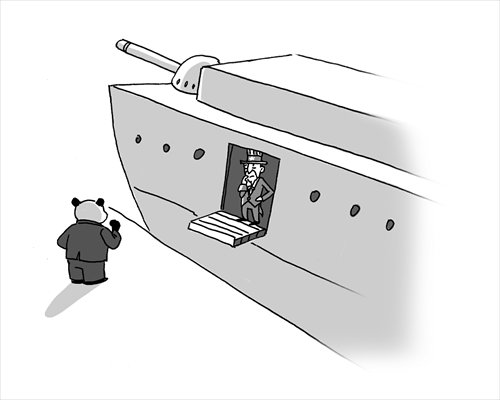Military exercise speaks to debate on region’s future

Illustration: Liu Rui/GT
The US is considering disinviting China from the 2016 RIMPAC military exercise, the world's largest with 22 nations participating. Why? Mainly to show Washington's displeasure over China's activities in the South China Sea. But the stance may make the bilateral relationship more complex.
A number of satellite photos showing China's PLA building ports and airstrips on expanded reefs and shoals has sparked a US debate about how to respond. Disinviting China from the next RIMPAC in 2016 is being suggested by some, including Senator John McCain, chair of the Senate Committee on Armed Services.
But there is mutual benefit from China's participation in RIMPAC. It acknowledges China's growing stature as a maritime actor, it increases transparency for both countries, and can be helpful in terms of better understanding maritime law. It also builds on the anti-piracy cooperation in the Gulf of Aden and improves potential cooperation in responding to natural or humanitarian disasters. For US officers to visit a Chinese aircraft carrier, and for Chinese officers to get a close-up look at US ships is a useful bit of transparency.
But the calls to eject China from the 2016 RIMPAC are not really about RIMPAC. They are a reflection of a larger US debate about China policy. Nor is it just the latest development in the South China Sea that has created concerns about Beijing's intentions.
There is US discomfort with China's larger economic and geopolitical footprint in the region and in the global system. This looms behind the Washington debate on how to impose a cost on China. The Pentagon is considering US air and naval actions near disputed South China Sea islets, and China has warned the US against taking provocative actions.
The recent Asian Infrastructure Investment Bank (AIIB) episode and the foolish US response is indicative of larger concerns that will shape the future of US-China relations: whether or not China seeks just a bigger weight in the international and regional system or whether China is seeking to create its own sinocentric system.
Adapting to the increased weight of a rising power is always a difficult affair for an established power, and this is certainly true for the US. That the long-standing bipartisan consensus on US China policy is being called into question at this time complicates things further: The US is entering the 2016 presidential election campaign, otherwise known as the silly season. Each candidate will posture to show they are "tougher" than the others on China.
But China's objective appears to be a desire to be treated as a major power, with influence to shape regional and global rules, not simply accept existing ones. Chinese Premier Li Keqiang was very emphatic in a recent Financial Times interview that China, does not "want to reinvent the wheel."
"I wish to emphasize that the AIIB and ADB can work in parallel in promoting Asian development. And the initiative of AIIB is not to reinvent the wheel. Rather it is intended to be a supplement to the current international financial system. China wants to work with others to uphold the existing international financial system. And if there is a need for reforming the current system, we are also ready to work with other countries to help make the system more just, reasonable and balanced."
Can this logic be applied to political and military issues in East Asia? As both Washington and Beijing prepare for Chinese President Xi Jinping's state visit to the US in September, there is a growing urgency for both leaders to explore ways to bridge the gap and reduce tensions in the Pacific.
The author is a senior fellow at the Atlantic Council. He served as a member of the US Department of State Policy Planning Staff from 2004 to 2008, and on the National Intelligence Council from 2008-12. opinion@globaltimes.com.cn. Follow him on Twitter at @Rmanning4.